What to do if the dishwasher does not drain the water and costs: decoding error codes
You loaded the dishes into your home assistant, set the program, the unit started up, and the normal washing process began. But something went wrong - the dishwasher does not drain the water and stands, and instead of the usual murmur of water, strange sounds are heard or an incomprehensible silence hangs. The situation is unpleasant, but dealing with it is not difficult. How?
In the article, we examined in detail the probable causes of malfunctions, proposed options for eliminating simple and serious breakdowns, and also described how they signal problems in the dishwasher drain system from different manufacturers.
The content of the article:
Standard error codes of popular models
Many modern PMM (dishwashers) have the option of self-diagnosis. It is embedded in the software module. Using certain algorithms, the machine identifies a failure and displays it in the form of a specific code.
The depth of this analysis depends on the manufacturer, model, generation of the control module.
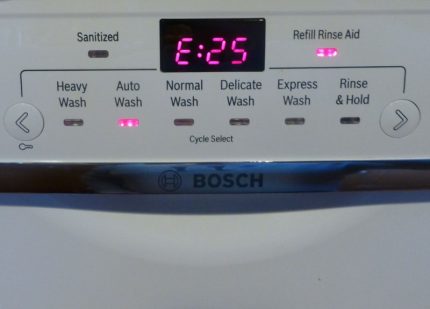
Error codes for some manufacturers:
If the dishwasher does not have a display, blinking sensors will report a breakdown. How exactly this happens depends on the model, usually the decoding of the light alert is given in the instructions.
Some Bosch modifications do not respond in any way to troubles in the drainage system and continue to wash dishes in used water. The user only knows about a breakdown after opening the door at the end of the program, when he sees that there is water in the tank.
How to reset error codes? There are two ways. The first is to turn off the PMM for 15-20 minutes so that it restarts. The second is to click on. and hold for a while.This resets the user settings and returns to the factory settings.
The principle of movement of water in the dishwasher
If other problems can be dealt with in fact, without understanding the reasons, then the absence of a drain requires a detailed analysis. And the first thing to figure out is PMM working principle.
The dishwasher does everything almost like a washing machine, only in the process it twice distills the water through its cleaning system.
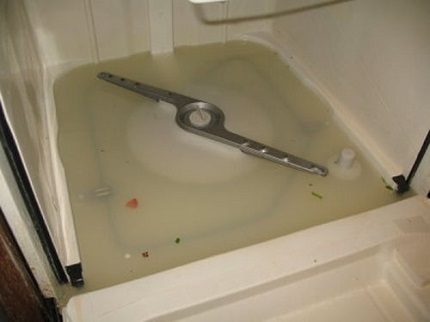
Coarse filtration occurs first, then fine filtration. The average water consumption is 9-12 liters. Savings are achieved due to the continuous purification of the same water. After the filter, the liquid enters the pump, returns to the rocker arm and sprinklers.
At the end of the program selected by the user, the water goes down, and the drain pump sends it to the sewage system. This does not happen if some element of the drainage system does not work correctly or is completely out of order.
Simple malfunctions and their elimination
When the machine does not drain the water, there are two possible answers to the question of what to do - to eliminate physical obstacles in the drain system or replace a broken part.
At any PMM operating instructions it is written that you should not neglect the simple rule - to clean the dishes from the remnants of food before loading into the camera. Garbage is the main cause of drain problems.
# 1 - kink or clogged drain hose
Pinching the drain hose is a simple but not the most common problem. Check how it is located. Perhaps the part is bent or clamped by some object. A blockage may form in the transferred area.
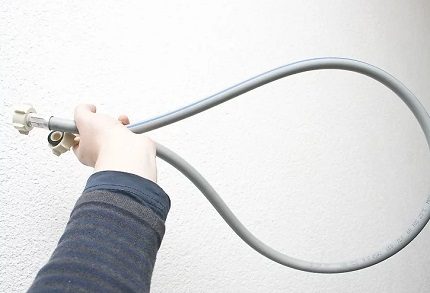
It will not be superfluous to press on all the elastic pipes to thin the dirt.
To remove the hose and clean it:
- Disconnect the machine from the mains.
- Remove the panel below the door by removing the screws.
- Disconnect the hose from the sewer, using pliers to remove the clamp.
- We lower one end of the tube into a bucket (pan) and turn on the drain mode. If water flows from it, the sewer or siphon is clogged (we will consider this case below). If there is no water, the problem is hidden in the machine itself.
- We knock out the garbage from the hose.
- We pass a powerful pressure of water through the tube, for which a garden hose is ideal. Pressure will knock out the remaining debris.
- You can clean the hose with a long wire, but proceed carefully. In order not to damage the tube itself, round the end of the wire with a bend.
When the hose is cleaned or you bought a new one, plug it back in, install the clamp, the bottom panel in place. The tube should be inclined - go slightly up from the machine and lower down. If everything is in order, look further.
# 2 - food debris in the filtration system
The problem with the drain may be in the banal bone, which jammed the filter assembly. If you look into this compartment, on some PMM models you can see a screw, when you unscrew it we get on the gear. It is jammed with small debris. It is necessary to remove all unnecessary so that the gear starts.
Clean PMM filters:
- We open the door and take out all the baskets.
- We unscrew the filter cover, which is located at the bottom of the camera.
- We take out the glass and the net.
- We rinse both parts. If you can’t do it simply under running water, a toothbrush and a detergent will come in handy from improvised means.
- We unscrew the drain pump cover and check this place for debris. Caution, not only food debris can fall here, but also fragments of dishes.
After all the manipulations, close the pump, return the filter to its place.
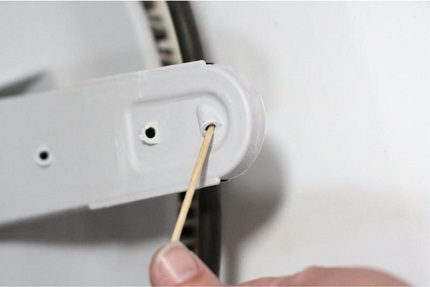
Are you sure that everything is in order? Test the machine.
# 3 - garbage in the sewer
If water leaked from the drain hose, the PMM is OK and problems are hidden in the sewer. Causes of clogging: impurities in the water, pipe corrosion, dirt, grease washed off the dishes. Minor debris can be removed with ordinary boiling water - it must be poured into the sewer hole.
Several effective ways sewer cleaning:
- Soda + Salt. In a glass of hot water, add soda and salt, dissolve, pour into the sewer, wait 10 minutes and rinse with a flowing stream.
- Reverse Blower. If the household has a vacuum cleaner with reverse blowing, wrap its pipe with a rag and insert it into the sewer hole, turn it on. The method is suitable for light pollution.
- Plunger. We use a plunger if its diameter fits under the hole.
- Metal cable. We clean the sewer special cableby inserting a flexible metal hose into the pipe and turning it. We take out the dirt and wash the pipe with water. For plastic pipes, this method is dangerous to use.
- Soda + Vinegar. Pour a glass of soda into the sewer and fill it with a glass of vinegar, close the hole with some kind of lid.
To dissolve contaminants, you can use chemicals from the shop.

Do not forget about protective gloves and general care when working with them - products can cause harm to skin and health.
# 4 - pump cleaning required
If the PMM is so designed that you can remove the pump yourself, it is better to clean it. Carefully remove the part, having previously unscrewed all the fasteners and eliminate blockages.
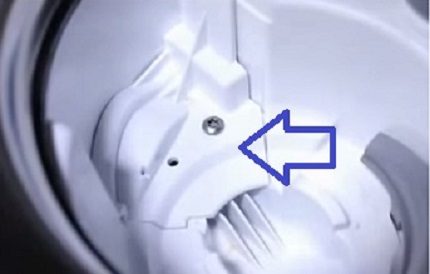
Next, you need to check the ease of rotation of the inner impeller. You don’t need to do this with your hands, take a handy item - a wooden stick, a pencil, so as not to damage your hands about possible fragments.
If the problem areas are cleared, run the machine in test mode. Still have a problem? Then you should pay attention to the malfunction in the mechanisms of the unit. Let's try to find the type of breakdown.
Serious situations and solutions
It is important to recall the warranty here. If it has not yet expired, contact your nearest service center. Almost all manufacturers have representative offices with a hot line. It is better to call and specify the coordinates of the nearest authorized service center.
Calling the master at home is usually free of charge, but replacement parts can be invoiced if repairs are not covered under the warranty case.
Situation # 1 - the pump is out of order
The task of the drain pump is to remove water from the machine. If it breaks, water will stand in the device until the owner changes the part. It is simple to determine the malfunction of the mechanism - when the stage of draining the water starts, the working pump creates a characteristic sound. Silence becomes a sign of failure.
The device has a peculiar design. The electric elements of the stator are located beyond the boundaries of the impeller and the magnet - so the device coils are completely isolated from water. Magnetic induction rotates the rotor with the impeller, due to which water sways.
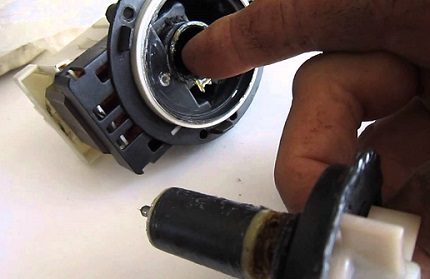
It is advisable to process the shanks with heat-resistant grease during the process, as the usual composition is easily washed off with hot water during washing dishes.
How to get to the pump:
- We remove water from the dishwasher manually or by tilting the machine forward.
- We take out the filter.
- We lay the unit on the rear panel to remove the pallet, which is screwed with self-tapping screws.
- Unscrew the part itself, remove the hoses.
- Check the rotation of the impeller. The absence of intermittent rotation is a clear sign of the need to replace the mechanism.
- We look at the resistance indicators by attaching the multimeter probes to the contacts on the pump. Normal parameters are a range within 200 ohms.
When assembling the pump housing, replace the gasket or use heat-resistant silicone sealant. Check also the wiring leading to the pump. In case of serviceability and wiring, the pump will have to be replaced.
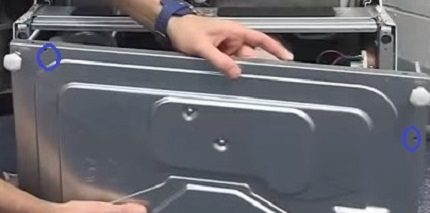
This part is practically unrepairable. In rare cases, you can do with greasing or removing dirt from the impeller. If the pump is completely defective, we contact the manufacturer’s representative, order a new part and make a replacement - we install a new pump according to the reverse disassembly algorithm.
Situation # 2 - the water level sensor is faulty
It is also called a pressure switch. This is an important part in a dishwasher that measures the water pressure in the PMM and sends a signal to the program unit. Such information is needed with every wash cycle. If the data does not arrive on time, the program crashes, the unit starts to work incorrectly.
By its device water sensor may have a mechanical or electronic device. His work is based on the principle of communicating vessels. The sensor tube is connected to the tank in such a way that when typing, the water in the tube and tank is at the same level.
When the pressure switch is faulty, water accumulates in the sump and does not leave. The defect can also be in a pressure vessel or a tube attached to the sensor. Causes of malfunctions: natural wear of the part, oxidation of contacts, problems with individual elements (puncture or blockage in the tube).
To get to this detail, you need to disconnect the machine from all communications, cover the floor with rags, lay the unit on its side. There are models where you need to remove the cover on the bottom or rear panel.

Now you need to find a pressure switch, a tube is diverted from it to a large plastic box - a pressure tank. The latter is fixed with two bolts. Next, remove the tube and the tank itself with pliers.
We check this item for contamination, clean it. The operation of the pressostat can be checked by blowing it into the tube - a working part will give a click, but after a couple of seconds.
Additionally, we check the electrical conductivity of the device with a multimeter. If the resistance gradually decreases to zero, the sensor is OK.
The broken part is not repaired - after disassembling it is impossible to assemble it back, so it needs to be replaced with an original device purchased from official representatives of the brand. To connect a new device, you need to turn off all the sensors, the pressure tube and put the pressure switch in place of the old one.
Situation # 3 - a software module broke
Repair or replacement of the software module is the most difficult problem associated with the restoration of the dishwasher. This part is the “brain” of the whole structure, which carries out the function of controlling all processes.
He knows how to analyze washing cycles and give commands to the nodes: drain the pump, heat the heater, and draw water into the inlet valve. A faulty software module either sends tasks incorrectly or is generally silent.
The reasons for this behavior may be a short circuit, natural wear of the device or errors in the firmware. In this case, you need to reprogram it or completely replace the board.
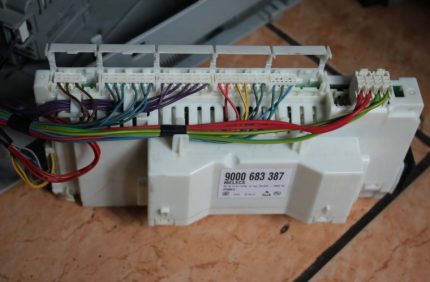
When program files are violated in the control unit module, the adapter will help to upgrade the firmware. Such an adapter is selected for each model individually.
If the machine does not work correctly after flashing, this indicates the presence of a physical breakdown of the control unit. Carrying out this procedure yourself is not recommended, so as not to aggravate the situation.
Most often, the unit is not repaired. There are very few craftsmen who are ready to identify the parts burned out on the board and replace them with new ones. Such manipulations require certain skills and experience. It’s easy to spoil a block, and this is one of the most expensive PMM parts.
To better understand the scope of the upcoming work, we suggest watching video instructions on how to fix various problems if the machine refuses to drain the water.
Conclusions and useful video on the topic
How to replace the drain hose - a step-by-step guide using the Beko PMM as an example.
Tips for checking the dishwasher pump.
Simple malfunctions that we examined in the first part of the article (hose bend, blockages) can be eliminated independently. More serious malfunctions require specialist intervention., especially in cases where the user does not have the necessary experience in the repair of household appliances and can further aggravate the situation.
Have something to supplement, or have questions about repairing the drain system of the dishwasher? You can leave comments on the publication, participate in discussions and share your own troubleshooting experience. The contact form is located in the lower block.

 Bosch dishwasher repair: decoding error codes, causes and troubleshooting
Bosch dishwasher repair: decoding error codes, causes and troubleshooting 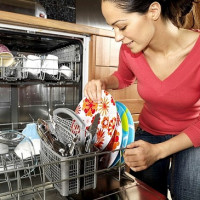 Do I need a dishwasher or who needs a dishwasher in the household?
Do I need a dishwasher or who needs a dishwasher in the household? 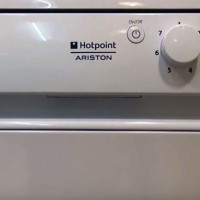 Ariston Hotpoint Dishwasher Errors: Error Codes and Their Solutions
Ariston Hotpoint Dishwasher Errors: Error Codes and Their Solutions 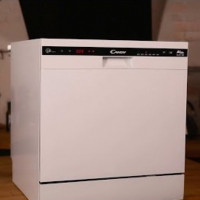 Candy CDCF 6E-07 dishwasher overview: is it worth buying a miniature
Candy CDCF 6E-07 dishwasher overview: is it worth buying a miniature 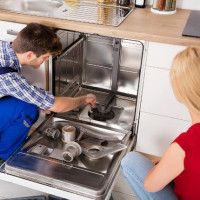 DIY repair of the dishwasher: analysis of breakdowns and errors + nuances of elimination
DIY repair of the dishwasher: analysis of breakdowns and errors + nuances of elimination 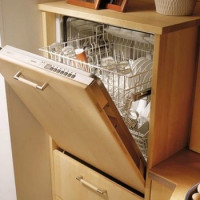 Built-in compact dishwashers: TOP-10 of the best models + tips for choosing
Built-in compact dishwashers: TOP-10 of the best models + tips for choosing  How much does it cost to connect gas to a private house: the price of organizing gas supply
How much does it cost to connect gas to a private house: the price of organizing gas supply  The best washing machines with dryer: model rating and customer tips
The best washing machines with dryer: model rating and customer tips  What is the color temperature of light and the nuances of choosing the temperature of the lamps to suit your needs
What is the color temperature of light and the nuances of choosing the temperature of the lamps to suit your needs  Replacement of a geyser in an apartment: replacement paperwork + basic norms and requirements
Replacement of a geyser in an apartment: replacement paperwork + basic norms and requirements
We have a Bosch dishwasher. She worked for 2 years without complaints, could not get enough, and it literally broke a month ago. Stopped draining water, as described here. The first thing I did was to check if the drain hose was pinched, but that was okay, then I checked the sewer. The water was leaving. It turned out that the drainage filter was clogged. Somehow I lost sight of the need to clean it from time to time. Now I follow this constantly.
I got an i20 error popping up on my Electrolux dishwasher. I checked the hose and filter - there are no signs of clogging. Could there be a problem in the pump? No sound is heard when draining, but I have not heard it before. Although perhaps just did not pay attention.
Hello. Does the error occur again when the machine is rebooted?
In general, you did the right thing to check the blockage. The only thing, blockage can be not only on the filter and drain, but also in the pump or pressostat. Also, the pressure switch could fail, it must be checked for operability.